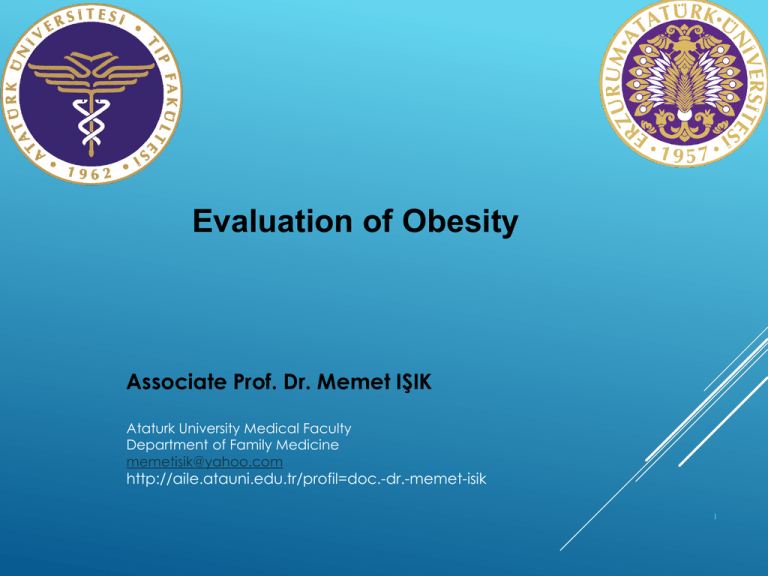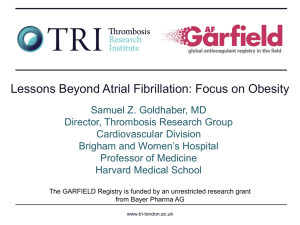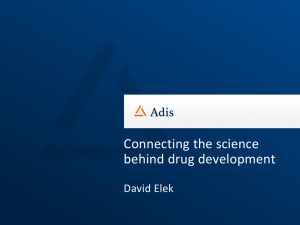Evaluation of obesity
advertisement

Evaluation of Obesity Associate Prof. Dr. Memet IŞIK Ataturk University Medical Faculty Department of Family Medicine memetisik@yahoo.com http://aile.atauni.edu.tr/profil=doc.-dr.-memet-isik 1 EVALUATION OF OBESITY • Major health concern in postindustrial societies • 60% of Americans older than 20 • Long term risk of becoming overweight: 50% • Social cost: 100 billion annual OBESITY PROMOTE • • metabolic syndrome, • Type 2 DM • Dyslipidemia • Hypertension • Increase risk of : • Hearth failure • Cancer • Premature death Metabolic syndrome is not a disease in itself. Instead, it’s a group of risk factors — high blood pressure, high blood sugar, unhealthy cholesterol levels, and abdominal fat. Increased risks of : • Impaired pulmonary function • Osteoarthritis • Gallbladder diseases • Surgical complications EVALUATION OF OBESITY CONDITION ASSOCIATED WITH OBESITY THAT USUALLY WORSENS AS THE DEGREE OF OBESITY INCREASES Hypertension Cardiovascular disease Dyslipidemia Type 2 diabetes Sleep apnea / obesity hypoventilation syndrome Osteoarthritis Lower extremity venous stasis disease Gastro-esophageal reflux Urinary stress incontinence Identify etiologic factors Assess weight status and fat distribution as risk factors for major diseases TASKS FOR PRIMARY CARE PHYSICIAN DEFINITIONS Obesity is a medical condition in which excess body fat has accumulated to the extent that it may have an adverse effect on health, leading to reduced life expectancy and/or increased health problems[1]. Overweight: BMI of 25-29.9 kg/ m2 Obese: BMI greater than 30 kg/ m2 Morbit obese: BMI greater than 40 kg/ m2 Body Mass Index: Body Wight( Kg)/ Height2 (meter) 1: WHO 2000 p.6 DISTRIBUTION OF BODY FAT a. Often characterized as centrally vs. peripherally located fat distribution b. Central obesity is characterized by an "android" or "apple" shape • Central obesity is more common in men and is a strong risk factor for several diseases • Ratio of waist (umbilicus) to hip (pubic syphilis) >0.85 is a risk factor (central form) • This ratio also correlates (r=0.4) with elevated serum triglyceride and low HDL c. Peripherally distributed ("gynoecia" or "pair" shape) is more common in women • Although not completely benign, peripheral (non-central) obesity appears to be less of a risk factor for cardiovascular disease than central obesity HISTORY INITIAL ENCOUNTER 1. Duration of obesity 2. Eating habits 3. Activity habits 4. Hour dietary recall 5. Previous weight loss attempts 6. Assess patient readiness 7. Weight loss expectations 8. Family history of obesity 9. Presence of comorbid conditions FOLLOW-UP Eating and activity habits 1. Measure Body Mass Index (BMI).. 2. General physical examination including: Waist circumference and body habitus DIAGNOSTIC CONSIDERATIONS 1. Determine the BMI-related health risk 2. Perform needed tests to rule out obesity related illnesses T3, T4 – if suspect hypothyroidism FBS – if suspect diabetes Serum cholesterol Dexamethasone suppression test – if suspect Cushing’s syndrome DIAGNOSTIC CONSIDERATIONS MANAGEMENT STEPS 1. Select weight reduction treatment option based on the determined health risk MANAGEMENT STEPS 2. Determine weight reduction exclusion: Pregnancy, lactation, osteoporosis, anorexia nervosa, unstable medical condition or terminal illness 3. Together with the patient, select a target BMI that the patient is willing to maintain 4. Create an energy balance between the energy consumed in food and daily physical activity 5. Establish permanent life style change strategies a. Eating Behavior Modification is essential but probably not sufficient i. Reduce total caloric intake by 500 Kcal per day to lose 1 kg per week ii. Keep records of food intake iii. Eat regular meals b. Exercise is necessary in all cases MANAGEMENT STEPS 6. Medication: Some medications are temporarily helpful as adjunct to reduced calorie diet especially in patients with BMI above 30 or 27 with other cardiovascular risk factors. a. Sibutramine (Reductyl, Meridia): a mixed neurotransmitter reuptake inhibitor which helps curb appetite. Start at 10 mg once daily then increase to 15 mg daily in 4 weeks. b. Selective Serotonin Reuptake Inhibitors - Fluoxetine (Prozac) at 20 mg daily – decreases appetite c. Certain stimulant compounds including Methylphenidate (Ritalin) – decreases appetite d. Orlistat (Xenical): Lipase inhibitor - decreases fat absorption.. 120 mg capsule taken during or up to 1 hour after each of 3 daily meals. If a meal contains no fat, medication is skipped. 7. Re-evaluate weight Desired outcomes Weight not more than 20% greater than norm for height reduction need and progress periodically WHEN TO REFER 1) Refer all to registered dietician for implementation of prescribed diet 2) Refer to “obesity treatment center” or endocrinologist if uncertain about diagnosis or patient desires multidisciplinary treatment or if BMI > 40 or BMI > 35 with significant comorbidity PATIENT EDUCATION 1) Explain the cause of obesity 2) Explain the prognosis 3) Advise about the complications of obesity 4) Advise to avoid fad diets 5) Advise to avoid self prescribed diet pills 6) Advise about the exercise program








